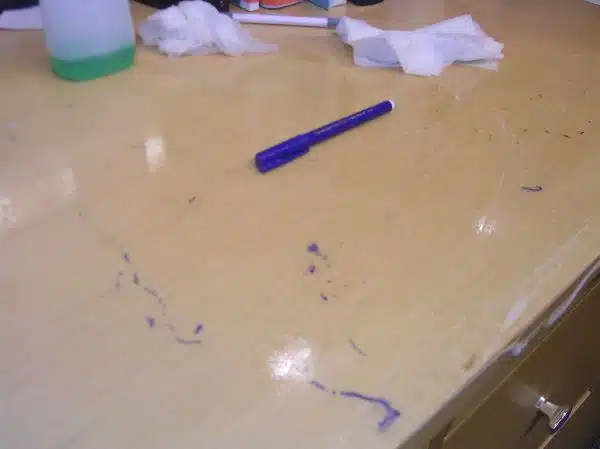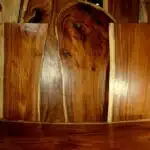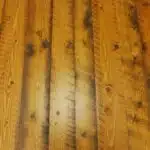As a professional cleaning expert, I have encountered numerous clients who struggle to remove permanent marker stains from their wooden furniture. Permanent markers can leave stubborn and unsightly marks on wood surfaces, making them difficult to clean. However, with the right techniques and materials, it is possible to remove these stains effectively.
Permanent marker stains on wood are a common household problem that can be frustrating and challenging to deal with. Many people resort to using harsh chemicals or abrasive cleaning methods that can damage the wood surface or fail to remove the stain altogether. In this article, we will explore some effective techniques for getting rid of permanent marker stains on wood without causing any harm to the surface. Whether you are dealing with an old stain or a new one, these tips will help you restore your wooden furniture’s natural beauty and prolong its lifespan.
Understanding Permanent Marker Stains On Wood
As a professional cleaning expert, it is essential to understand permanent marker stains on wood. These types of stains can be stubborn and challenging to remove. Permanent markers consist of dyes, pigments, and solvents that are designed to leave a long-lasting mark. When these markers come into contact with wood surfaces, they tend to penetrate the surface and leave an unsightly stain.
The causes of permanent marker stains on wood differ depending on the type of wood surface. For example, porous woods such as maple or oak may absorb the ink more quickly than non-porous ones such as cherry or walnut. Additionally, certain finishes or sealants may make it more difficult to remove marker stains because they prevent the ink from penetrating the surface fully.
It is important to note that attempting to remove permanent marker stains from wood without proper knowledge and techniques can result in further damage to the surface. Therefore, before attempting any cleaning method, it is crucial to identify the type of wood surface first.
Identifying The Type Of Wood Surface
Before attempting to remove permanent marker stains from a wood surface, it is essential to identify the type of wood. Identifying wood types can be challenging, especially for those who are not familiar with different types of woods. However, there are several ways to differentiate between them. One way is to examine the grain pattern and color of the wood. Each type of wood has a unique pattern and color that distinguishes it from others.
Differentiating wood finishes is also crucial in determining how to remove permanent marker stains without damaging the finish or leaving any residue behind. Some common types of finishes include lacquer, varnish, shellac, and polyurethane. Each finish requires a specific approach when cleaning and removing stains. For instance, lacquer finishes are delicate and require gentle cleaning methods; on the other hand, polyurethane finishes are more durable but may require stronger cleaning solutions.
To sum up, identifying the type of wood surface is vital before attempting any cleaning or stain removal methods. Differentiating between various types of finishes is also crucial in determining how to clean effectively without causing damage or leaving residue behind. By understanding these factors, homeowners can take appropriate steps towards removing permanent marker stains from their wooden surfaces while preserving their natural beauty.
Moving forward with this topic about how to get permanent marker stains off wood surfaces requires gathering necessary cleaning materials that will help make the process faster and easier.
Gathering Necessary Cleaning Materials
Identifying the type of wood surface is crucial in determining the appropriate cleaning materials to use. Different types of wood have varying degrees of sensitivity to certain chemicals and cleaning agents. For instance, hardwood floors require a different type of cleaner than softwood furniture. Before proceeding with any cleaning process, it’s essential to identify the type of wood surface you’re dealing with.
Choosing appropriate cleaning materials can make a significant difference in the effectiveness of removing permanent marker stains off wood surfaces. Abrasive cleaners should be avoided as they can damage the finish on wooden surfaces. Instead, opt for mild cleaners that are safe for use on wood surfaces such as white vinegar, baking soda or dish soap. These cleaning agents are gentle enough not to cause damage to your wooden surface but powerful enough to remove most stains.
Eco-friendly cleaning options are another great choice when trying to remove permanent marker stains from wooden surfaces. These green alternatives are not only effective but also gentle on your surfaces and safe for the environment. Some common eco-friendly options include hydrogen peroxide, lemon juice, olive oil and rubbing alcohol. Using eco-friendly products not only helps protect your wooden surfaces but also promotes sustainable living practices.
Now that we’ve discussed choosing appropriate cleaning materials and eco-friendly options, it’s time to prepare the cleaning solution for removing permanent marker stains from wooden surfaces. This step involves mixing your preferred cleaning agent with warm water in a spray bottle while following specific instructions if indicated on the product label. Once you have your cleaning solution ready, it’s time to move onto the next step – applying the solution onto the stained area carefully without causing damage or discoloration to your wooden surface.
Preparing The Cleaning Solution
Congratulations! You have finally realized that permanent marker stains on your beloved wooden surface require immediate attention. But before you jump into action, let’s take a moment to appreciate the irony of this situation. A permanent marker on a surface that is meant to last for generations is an unfortunate reminder that even the most durable materials are susceptible to damage. However, with the right cleaning solution and technique, you can restore your wooden surface to its former glory.
The first step in preparing the cleaning solution is determining the mixing ratios. Depending on the severity of the stain, you may need to adjust these ratios accordingly. For a mild stain, mix equal parts of baking soda and water until it forms a paste-like consistency. For moderate stains, try mixing rubbing alcohol and water in a 1:1 ratio. If all else fails, consider using hydrogen peroxide or acetone as alternative cleaning solutions.
Once you have prepared the cleaning solution, it’s essential to test it on a small area before proceeding further. This step will ensure that there is no discoloration or damage to your wooden surface due to chemical reactions between the cleaning solution and wood’s natural oils. Once you have confirmed that there are no adverse reactions, apply the cleaning solution directly onto the stain and gently scrub with a soft-bristled brush until it fades away. Remember never to use abrasive materials as they can scratch or damage your wooden surface irreparably.
Now that we know how to prepare an effective cleaning solution let us move forward with caution and test our solution on a small area first- this will help us identify any potential side effects before we proceed further into removing those pesky marker stains from our beloved wooden surfaces!
Testing The Solution On A Small Area
Before using any cleaning solution on the entire surface of your wooden furniture, it is essential to test it on a small, inconspicuous area. This step will help you determine the accuracy of the solution and avoid potential damage to your furniture. It’s recommended to test the cleaning solution on an area that is hidden from view, like the backside or underside of the furniture.
To test the accuracy of a cleaning solution, apply a small amount of it onto a soft cloth and gently rub it onto the wood’s surface. Make sure to use a light hand when rubbing and avoid applying too much pressure. Observe how the wood reacts to the cleaning solution – if there is no discoloration or other signs of damage, then you can proceed with applying the solution to the stain.
Testing for potential damage is also crucial before applying any cleaning solution on wooden surfaces. Some solutions may be too harsh and cause irreparable damage to your furniture. If you notice any changes in color or texture after testing, do not continue with using that particular cleaning agent. Instead, try another method or seek professional advice from a furniture restoration expert.
Now that you have tested your chosen cleaning solution on a small area without causing any harm or discoloration, you can proceed confidently in removing those unsightly permanent marker stains from your wooden furniture. In our subsequent section, we will discuss how to apply the solution safely and effectively onto the stained area.
Applying The Solution To The Stain
- Gathering the necessary supplies is the first step to removing permanent marker stains from wood surfaces.
- It is important to test the chosen solution on a small, inconspicuous area of the surface first, to ensure the solution does not damage the wood.
- Applying the chosen solution to the permanent marker stain should be done carefully, ensuring the solution does not spread beyond the area of the stain.
- For best results, the solution should be left on the stain for a few minutes before being wiped away.
- It is advised to use a soft-bristled brush to help remove the stain, after the solution has been left on for a few minutes.
- The area should be wiped clean with a soft cloth or sponge after the stain has been removed.
Gather Supplies
When tackling permanent marker stains on wood, the first step is to gather the necessary supplies. Depending on your preference, you can opt for DIY or professional cleaning solutions. DIY solutions are cost-effective and can be easily made from organic ingredients such as vinegar, baking soda, and lemon juice. However, if you prefer a faster and more effective solution that uses chemical agents, then hiring a professional cleaner may be your best bet.
If you choose to go the DIY route, make sure to have white vinegar or rubbing alcohol, baking soda, a soft cloth or sponge, and a bowl of warm water at hand. For a chemical-based solution, you will need acetone or nail polish remover and a soft cloth or sponge. Be careful when using these chemicals as they can cause discoloration or damage to the wood if not used correctly.
Ultimately, whichever cleaning method you choose depends on your personal preferences and the severity of the stain. With proper supplies in hand and some patience and elbow grease, removing permanent marker stains off wood is possible regardless of which method you choose.
Test Solution
Before applying any solution to the stain, it is essential to test it on an inconspicuous area of the wood. Testing a solution helps determine its effectiveness and prevents further damage to the surface. Alternative methods may have different chemical compositions, and without testing, one cannot be sure how the wood will react to them.
To test a solution, apply a small amount onto an unnoticeable area of the wood and wait for 10-15 minutes. If the solution does not cause any discoloration or damage, then it is safe to use on the stained spot. This step is crucial since some cleaning agents can erode or dissolve layers of the protective finish, which can lead to permanent staining.
Effectiveness comparison between DIY solutions and commercial cleaners should also be considered when choosing a cleaning agent. While DIY solutions are cost-effective and easy to make from household ingredients, they may take longer to produce results. Commercial cleaners, on the other hand, are more potent and faster in removing stubborn stains but can be costly compared to homemade remedies. It is important to weigh these factors against your budget and time constraints before deciding which method to use for removing permanent marker stains off wood.
Apply Solution
After testing the solution on an inconspicuous area of the wood, it is time to apply it to the stain. There are two broad categories of cleaning agents: commercial cleaners and DIY solutions. When choosing a cleaning agent, consider their effectiveness in removing the permanent marker stains off wood. It is also essential to keep in mind eco-friendly options when selecting a solution.
For DIY solutions, there are many options that can be made from household ingredients such as vinegar, baking soda, and lemon juice. These remedies may take longer to produce results but are cost-effective and environmentally friendly. To apply a DIY solution, use a clean rag or sponge to rub the mixture onto the stain gently. Be sure not to scrub too hard as this can damage the surface of the wood.
Commercial cleaners are more potent than DIY solutions and require less effort in removing stubborn stains. However, they can be costly compared to homemade remedies and may contain harmful chemicals that can harm both humans and pets. To use commercial cleaners, follow the manufacturer’s instructions carefully and ensure that you wear protective gloves and masks to avoid skin or respiratory irritation.
Letting The Solution Sit
After applying the solution to the stain, it is important to let it sit for a while. There is a theory that suggests that giving the solution enough time to penetrate the wood can increase its effectiveness in removing the permanent marker stains. This idea is supported by many experts who have tried and tested different methods of removing stains from wood surfaces.
Benefits of Time:
- Allows the solution to penetrate deeper into the wood
- Increases chances of completely eliminating the stain
- Reduces effort needed to scrub off the stain
- Prevents damage to the wood surface caused by excessive scrubbing
Importance of Patience:
- Avoids frustration caused by not seeing immediate results
- Prevents further damage that may be caused by using abrasive cleaning methods
- Gives time for a thorough cleaning process which can prevent future stains from appearing on wood surfaces
When letting the solution sit, it is recommended to cover it with plastic wrap or a damp cloth. This prevents evaporation and ensures that the solution stays moist, making it more effective in dissolving and lifting off stubborn stains. After around 30 minutes, check if there are any visible changes on the stained area. If there are still traces of permanent marker left, repeat the process until all marks are gone.
Transitioning to scrubbing gently: Once enough time has passed and you see that most or all of stain has been lifted off, it’s time to move on to gently scrubbing off any remaining residue.
Scrubbing The Stain Gently
Once you have prepared the surface of the wood, it’s time to start scrubbing the stain gently. One effective method of removing permanent marker stains from wood is by using a Magic Eraser. This sponge-like product works wonders on tough stains and requires minimal effort.
To use a Magic Eraser, moisten it with water and gently rub it over the stained area. Make sure not to press too hard, as this could damage the wood. The eraser should start to lift the stain from the surface of the wood as you rub in a circular motion. Continue until all visible traces of the stain are gone.
Another method that can be used for stubborn stains is heat treatment. Using a hairdryer on high heat, apply direct heat to the stained area for several seconds at a time. As you apply heat, use a cloth to wipe away any loosened pigment from the surface of the wood. Be careful not to scorch or burn the wood during this process.
Transition: If after trying these methods, there is still some evidence of the stain remaining on your wooden surface, don’t worry! There are additional steps you can take to remove it completely.
Repeating The Process If Necessary
Sometimes, one application of the cleaning solution may not be enough to remove the permanent marker stain from wood. If this is the case, do not lose patience and repeat the process until the stain disappears. Remember to let the wood dry completely before applying any further solutions.
Applying heat can help reactivate the cleaning solution and penetrate deeper into the wood fibers, making it easier to remove any remaining stains. To do this, try using a hairdryer on low heat directly over the stained area for a few minutes. Be careful not to overheat or damage the wood surface.
If repeating the process with regular cleaning solutions does not work, there are specialized products available in most hardware stores that are designed specifically for removing permanent marker stains from wood surfaces. These products may require more time and effort but can be effective in removing even stubborn marks.
When dealing with tough stains, persistence is key. Don’t get discouraged if it takes several rounds of cleaning to completely remove the mark from your wood surface. It’s important to be patient and thorough when trying to clean up tough stains like these.
To ensure that you have fully removed all traces of cleaning solution or specialized products, it’s crucial to dry out your wooden surface thoroughly before moving onto other methods or steps of cleaning. This will also help prevent any further damage or staining from occurring on your wooden surface in future cleaning attempts.
Drying The Surface
After repeating the process of removing permanent marker stains on wood, it is important to allow the surface to dry properly. This step is crucial in ensuring that the wood does not suffer from further damage or discoloration caused by moisture. You can use a clean and dry cloth to wipe off any excess moisture on the surface.
If the stain persists even after repeating the cleaning process, you can try using sandpaper to remove it. Start by gently sanding the affected area until you see some of the stain being removed. Be careful not to apply too much pressure as this can cause damage to the surface of the wood. Once you have removed as much of the stain as possible, you can proceed with applying heat to further remove any remaining marks.
Applying heat is an effective way of removing stubborn permanent marker stains from wood surfaces. You can use a hairdryer set at a high temperature or a heat gun for this purpose. Simply point it towards the stained area and move it back and forth until you see some of the marks disappearing. It is important to note that this method may not work for all types of wood, so it’s best to test a small inconspicuous area first before proceeding with this technique.
Table: Methods for Removing Permanent Marker Stains from Wood
| Method | Description | Pros | Cons |
|---|---|---|---|
| Rubbing Alcohol | Soak a cloth in rubbing alcohol and gently rub over stains | Inexpensive and readily available | May cause discoloration or damage on certain types of wood |
| Baking Soda and Water | Mix baking soda and water into a paste and apply onto stains | Non-toxic and gentle on wood surfaces | May require multiple applications |
| Sandpaper & Heat Application | Gently sand affected area then apply heat using hairdryer or heat gun | Effective in removing stubborn stains | Can cause damage to the surface of the wood if not done carefully |
Once you have removed the permanent marker stain from your wood surface, you can proceed with polishing or waxing the wood to restore its natural shine. This step will also help protect the surface from future damage and discoloration caused by exposure to moisture or other elements. To polish or wax your wood surface, use a soft cloth and apply a small amount of wax onto it. Rub it onto the surface in a circular motion until you achieve a desirable shine. Repeat this process as necessary to maintain the quality of your wood furniture or flooring.
Polishing Or Waxing The Wood
Using furniture polish is an effective way to remove permanent marker stains from wood. Apply the polish onto a clean cloth and gently rub it onto the affected area. Then, wipe off the excess polish with another clean cloth. If the stain persists, repeat the process until it disappears.
Buffing the wood surface after using furniture polish can help restore its shine and smoothness. Use a soft cloth to buff the surface in circular motions until it becomes glossy. This technique can also help blend in any remaining discoloration caused by the stain.
Another option is to use wood wax instead of furniture polish. Apply a thin layer of wax onto the stained area and let it sit for a few minutes before wiping it off with a clean cloth. The wax will help fill in any scratches or holes caused by the stain and give the wood a protective coating against future damage.
To prevent future stains on your wood surfaces, consider using coasters under drinks, placing tablecloths or placemats under dishes during meals, and avoiding placing sharp objects directly on top of your furniture. By taking these simple precautions, you can keep your wood looking beautiful for years to come.
Preventing Future Stains
After polishing or waxing the wood, it is important to consider preventive measures for future stains. While it may not be possible to completely eliminate the risk of stains, there are several long term solutions that can minimize the chances of them occurring.
One effective measure is to use coasters or placemats when placing drinks and food on the wooden surface. This helps prevent any spills from directly contacting the wood and potentially leaving a stain. Additionally, using tablecloths or runners can add an extra layer of protection while also enhancing the aesthetic appeal of the furniture.
Another preventive measure is to avoid placing items with permanent markers or pens on the wooden surface. If it is necessary to do so, ensure that a protective cover such as a sheet of paper or plastic is placed underneath. It’s also important to keep markers and other writing utensils out of reach from children who may accidentally write on the furniture.
Common mistakes to avoid when trying to prevent stains include using harsh chemicals or abrasive materials that can damage the wood finish. It’s also important not to leave wet items such as glasses or dishes on the surface for extended periods of time as this can cause water damage. By taking these preventive measures and avoiding common mistakes, you can protect your wooden furniture from unwanted stains and maintain its longevity.
Common Mistakes To Avoid
Common misconceptions about removing permanent marker stains off wood can lead to damaging the surface, and potentially making the stain even more difficult to remove. One common mistake is using harsh chemicals or abrasive materials that can scratch or discolor the wood. This can cause permanent damage to the wood and make it unsightly. It is important to avoid using these types of products and instead use gentle, non-toxic alternatives.
Effective removal techniques include using rubbing alcohol, baking soda, or white vinegar mixed with water. These solutions are safe for most types of wood and can help break down the pigment in the marker stain without causing any damage to the surface. Another effective technique is using a magic eraser, which gently removes stains without harming the wood. However, it is important to test any solution on an inconspicuous area of the wood first before applying it to larger areas.
While many people are able to successfully remove permanent marker stains from wood on their own, there may be times when professional help is needed. If the stain has been on the wood for an extended period of time or if previous attempts have been unsuccessful, it may be best to seek professional cleaning services. A professional cleaner will have access to specialized tools and products that can effectively remove stubborn stains without damaging the wood surface.
When To Seek Professional Help
- Severe stains from permanent markers on wood can be a difficult issue to deal with, and in such cases it may be best to seek professional help.
- Professionals are trained to identify the type of wood and the severity of the stain, and know the best course of action for removal.
- Damaged surfaces can worsen staining, and should be professionally assessed prior to any attempts at cleaning or removal.
- Professional help is also recommended when attempting to clean or remove stains from antique or delicate wood surfaces.
Severe Stains
When it comes to severe marker stains on wood, sometimes the best course of action is to seek professional help. While there are various DIY methods that can be employed, these may not always work for deeply ingrained marks. In such cases, a professional cleaner can offer more advanced bleaching techniques that are both safe for the wood and effective in removing the stain.
One option a professional cleaner may consider is sanding. This involves using an abrasive material to remove the top layer of wood where the stain has set in. However, this method requires skill and precision as over-sanding can damage the wood’s surface. Additionally, sanding may not always be appropriate depending on the type and quality of wood involved.
Ultimately, when faced with stubborn marker stains on wood, it is best to consult a professional who can assess the severity of the problem and recommend appropriate solutions such as bleaching or sanding options. Doing so not only ensures a successful outcome but also protects your investment by preventing further damage to your wooden pieces.
Damaged Surfaces
When it comes to maintaining the appearance of wooden furniture, scratches and damages are inevitable. While minor surface scratches can often be remedied with simple DIY techniques, deeper scratches may require more advanced solutions. Attempting to repair deep scratches without proper knowledge and tools can lead to further damage, making it crucial to seek professional help in such instances.
Professional cleaners have access to specialized tools and products that can effectively repair damaged surfaces without causing further harm. They also possess the necessary skills and expertise required to assess the severity of the damage and determine the best course of action. In many cases, repairing deep scratches involves sanding or refinishing the wood surface, which requires precision and care.
Preventing further damage is another critical aspect that professional cleaners prioritize when repairing damaged surfaces. The use of incorrect cleaning products or techniques can cause irreparable harm to wooden pieces, leading to costly replacements. Seeking professional help not only ensures successful repairs but also protects your investment by preventing further damage to your cherished wooden items.
Conclusion
Having explored the instances wherein professional help is necessary for removing permanent marker stains from wood, it is important to consider the long term effects of using certain methods. Harsh chemicals and abrasive materials can cause damage to the wood’s finish, leaving behind unsightly marks and scratches that will require additional repair. It is crucial to carefully evaluate each method before proceeding with stain removal.
For those who prefer alternative methods, there are several options available for removing permanent marker stains from wood. One popular method involves using a mixture of baking soda and toothpaste, which can be applied directly onto the stained area and left to sit for several minutes before being wiped away with a damp cloth. Another option is to use rubbing alcohol or vinegar, both of which are known for their stain-removing properties.
In conclusion, while professional help may be required in some cases, it is important to weigh the potential long term effects of using certain methods when attempting to remove permanent marker stains from wood. For those who prefer alternative solutions, there are several effective methods that can be used without causing damage to the wood’s finish. By carefully evaluating each option before proceeding with stain removal, individuals can successfully remove stubborn stains while preserving the integrity of their wooden surfaces.
Conclusion
Permanent marker stains on wood can be frustrating, but with the right approach, they can be effectively removed. Understanding the type of wood surface is essential before gathering necessary cleaning materials and preparing the cleaning solution. It’s important to test the solution on a small area before applying it to the entire stain. Preventing future stains is crucial, and avoiding common mistakes such as using abrasive cleaners or scrubbing too hard is essential.
If all else fails, seeking professional help may be necessary. Remember that taking care of your wood surfaces requires patience and attention to detail. By following these steps and avoiding common mistakes, you can successfully remove permanent marker stains from your beloved wooden surfaces.
In conclusion, removing permanent marker stains from wood requires careful consideration of the type of surface being cleaned, gathering appropriate cleaning materials, and preparing a suitable cleaning solution. It’s crucial to avoid common mistakes and test solutions before applying them to larger areas. Proper prevention techniques will help minimize future staining incidents. Remember that taking care of your wooden surfaces requires patience and attention to detail. If you encounter stubborn stains, seeking professional help may be necessary.
Image Credits
- “Drea DREW All Over My Desk With A Magic Marker And Now It Won’t Come Clean!” by spike55151 (featured)





























